Content |
|---|
Characteristics "Pug"
Coexistence is important that you have with your new friend. Before considering the acquisition of a dog of the breed "Pug" you know certain factors. Not all breeds of dogs are apt to live in an apartment, you must take into account his character, their need for exercise, their interaction with other pets, their care and if you have small children, their level of tolerance towards them.
Adaptation ⓘ5.0 out of 5 stars (based on 1 review)
|
friendly dog ⓘ5.0 out of 5 stars (based on 1 review)
|
hair loss ⓘ4.0 out of 5 stars (based on 1 review)
|
|---|---|---|
Affection level ⓘ5.0 out of 5 stars (based on 1 review)
|
Need for exercise ⓘ1.0 out of 5 stars (based on 1 review)
|
Social need ⓘ5.0 out of 5 stars (based on 1 review)
|
Home ⓘ5.0 out of 5 stars (based on 1 review)
|
Toilet ⓘ1.0 out of 5 stars (based on 1 review)
|
Friendly with strangers ⓘ5.0 out of 5 stars (based on 1 review)
|
barking ⓘ3.0 out of 5 stars (based on 1 review)
|
Health ⓘ5.0 out of 5 stars (based on 1 review)
|
Territorial ⓘ4.0 out of 5 stars (based on 1 review)
|
Cat friendly ⓘ5.0 out of 5 stars (based on 1 review)
|
Intelligence ⓘ3.0 out of 5 stars (based on 1 review)
|
Versatility ⓘ3.0 out of 5 stars (based on 1 review)
|
Child friendly ⓘ4.0 out of 5 stars (based on 1 review)
|
Surveillance ⓘ3.0 out of 5 stars (based on 1 review)
|
joy ⓘ4.0 out of 5 stars (based on 1 review)
|
History
The Pug or Dutch bulldog (also known as Chinese Pug, Mops, Puggu) is a breed of dog miniature with wrinkled face and a body of small to medium-sized, originating in China.
This breed is often summed up as “multum en parvo” (much in little), describing the personality of the Pug related to its small size.
The word “Pug” It may come from old English Pugg, it is an affectionate adjective it would be something like a little playful demon or monkey. Pug puppies are called Puglets.
The breed of dog Pug, has very ancient origins. It was raised and selected in China, country where he was the favorite dog of officials, It is also a very popular in Holland and England breed of dog.
In fact, England claimed the patronage of la raza, since they had carried out excellent selection work for years. Finally, part of the patronage of the race was awarded to Great Britain.
This wrinkled and funny puppy, He was a faithful companion of the ladies of the 19th century in Italy.
As almost all dog breeds, it knew how to have its difficult moments, especially when the world wars took place, but it has not been on the verge of extinction like others.
Today the breed Pug it is highly appreciated in almost every corner of the world.
Did you know??
Among the rich and famous are admirers of the Pug King Louis XIV, Josefina, Empress of Napoleon, Queen Victoria, the Duke and Duchess of Windsor and fashion designer Valentino.
Physical characteristics
It is a dog under, solid square and compact appearance, well proportioned and muscular; the head, large, rounded and solid appearance, is covered with folds; the muzzle is square and flat; the eyes, large, bulging, they are dark; It has straight legs and looped collector queue. The hair is tight, smooth and shiny.
The Pug or Dutch bulldog can be silver or soft apricot with a black mask, in both cases it presents a black stripe that goes from head to tail; It can also be pure black or white which is the more scarce and expensive of all.
It measures each 30 cm to cross and weighs between 6 and 8 kg. His confident nature, docile and friendly makes the Pug an appreciated companion animal. The Pug is particularly a dog “with sense of humor”, exhibiting very human facial expressions given its bone structure. Due to its striking appearance, some people tend to think that the characteristics of the Pug are the result of genetic manipulation or inbreeding.. But, the characteristics of the Pug are similar in the last five hundred years, period in which Europeans began it importing from China.
The Pug's tail has a characteristic spiral or letter shape “Q”. This variation in the way of the tail is due to the vertebrae in this portion of the column are actually hemivertebra. In some few puppies, This alteration of the shape can be extended to the rest of the column and the animal presents spina bifida.. The spine of the animal must feel before purchasing to avoid choosing a sick puppy. An animal that suffers from this malformation should not be reproduced in order to not pass this problem to their offspring.
Given the shape of the skull, the eyes of the Pug have a bouncy and lively appearance. To find the eyes located above, they are more exposed to friction with plants and objects to the eyes of other animals, and it is advisable to take them to the vet as soon as possible if they have an injury. It is recommended that the owners of the Pug clean the eyes of the animal once a week with a clean cotton moistened with cold boiled water or cold tea, in order to remove secretions or dirt.
The characteristic wrinkles of the face can also accumulate secretions and dirt. It is recommended at least once a week clean gently between wrinkles using the same method. It is not necessary to apply SOAP, creams or other substances. Simple toilet is enough and to spare.
The Pug is a short hair dog, tends to constantly pelechar, so his tenure is not recommended for persons allergic or asthmatic. They have a characteristic pungent odor that may bother some people, but that decreases a bath every couple of weeks.
The biggest health problem presented by the Pug is one that is completely preventable and treatable, and that depends entirely of the OWNER. This disease is the OBESITY. A Pug it receives proper care can live more than fourteen years, Although on average they tend to live around ten.
One 1% Puppy can reach presenting a degenerative neurological disease called Pug encephalitis (or tap for its acronym in English). This disease is lethal and has no known cure. For this reason dogs must not be reproduced within the two years, in order to not transmit the gene to their offspring. Last year of life it is very unlikely that the Pug will have this disease.
Character and skills
The Pug aren't aggressive animals. Like any dog, they can bite, but it is very rare that this happens without the animal mistreatment. The Pug do honor to his motto “Multum in parvo” and they do not amilanan to larger breeds dogs, which you can get into trouble.
Before humans, the Pug tend to be playful and seek interaction. However can be apprehensive to strangers, and with their barking to announce the presence of unknown people. Although its size are not guard dogs, If they are good “alert dogs”.
The Pug show a moderate level of intelligence, being able to use their short snouts and front paws to obtain objects out of reach. They sometimes tend to stubbornness, and do not necessarily come when you are called, but rather when crave it. Despite this, they do not go far from their owners and prefer their company to that of other dogs..
During the first years of life Pug may occasionally be hyperactive (run, jumping and barking constantly) but this characteristic tends to disappear over the years. The Pug 5 and older tend to be calmer and enjoy the chairs more than the street.
There is a tendency to believe that Pug they are animals “sickly”, which is very far from reality. One Pug healthy will be energetic and playful, and even a bit hyperactive in its first years of life. Its solid structure makes they tolerate well the game with children and adults, and its particularly hard head can cause bumps and falls in young children and older adults.
The Pug It's a small animal, and although strong, requires very little food. But, being a pet, owners tend to supercharge them and share their food with them. This must not be. The Pug can perfectly feed on a cup of dry food in the morning and a cup at night, and you won't go hungry or require any extra supplements.
An obese Pug is not a Pug “beautiful”, on the contrary, It is an animal that sick because you can not breathe well, be it exhausted easily and will begin to suffer from problems in the spine and joints. A Pug fed healthy is, on the other hand, a robust animal, with his sharp and clearly visible muscles under the skin. A healthy Pug can run as fast as any other dog, and you can skip two or three times its own height. While the animal enjoys eating meals extras and receive “prizes” occasionally, is task of the owner to ensure that the quantity and quality of food that consumes is adequate.
Images “Pug”
Videos “Pug”
Type and recognitions:
- FCI CLASSIFICATION: 253
- Group 9: Companion and Toy Dogs
- Section 11: Small Molossian type Dogs. Without working trial.
Federations:
FCI breed standard "Pug"
Alternative names:
1. Chinese pug, Dutch mastiff (English).
2. Pug (French).
3. Pug (German).
4. Carlin, Mops (Portuguese).
5. Pug chino, Mops, Pug carlino, Doguillo (español).
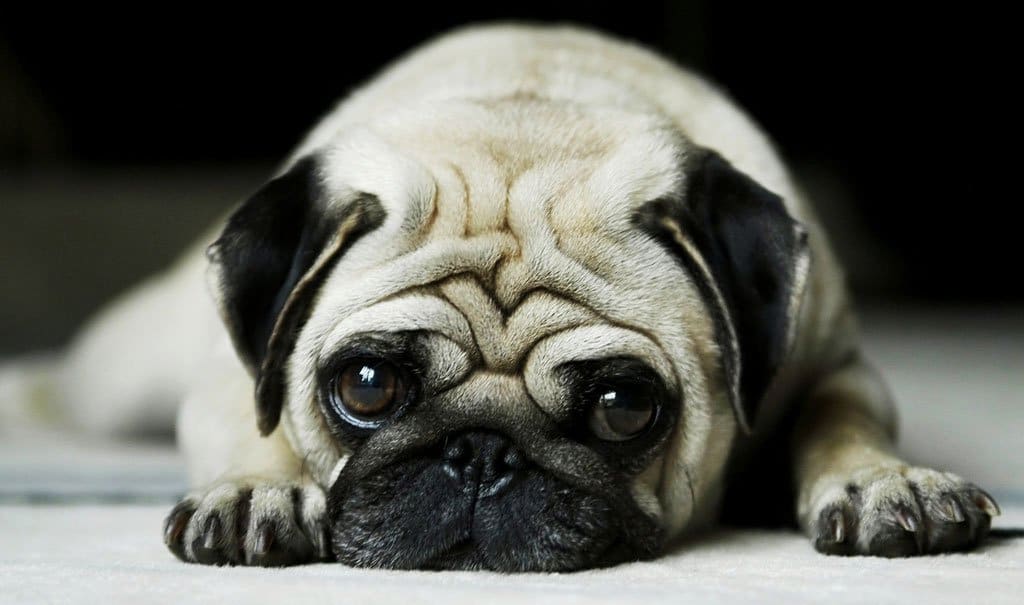
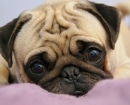
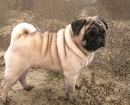
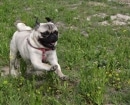
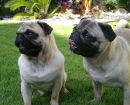
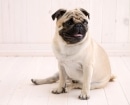
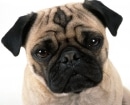
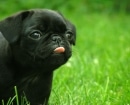
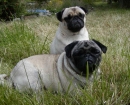
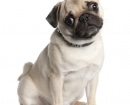

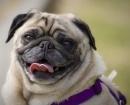

 pug and a duck
pug and a duck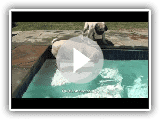 How pugs cross pools
How pugs cross pools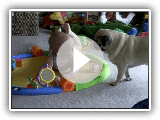 Pug tactics to steal from baby Jack!
Pug tactics to steal from baby Jack!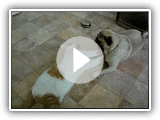 Pug and cat playing Bram vs Billy! playing funny!
Pug and cat playing Bram vs Billy! playing funny!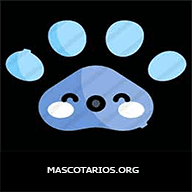
Visitor Rating: 5 Stars